Negotiation Strategies: Thinking Styles, BATNA, and ZOPA Analysis
VerifiedAdded on 2021/06/16
|8
|1744
|48
Report
AI Summary
This report provides an analysis of negotiation skills, focusing on the importance of thinking styles and their impact on the negotiation process. It explores different thinking styles, including monarchic, hierarchic, oligarchic, and anarchic, and discusses how an individual's thinking scope (internal vs. external) influences their approach to negotiation. The report uses a case study involving the sale and purchase of a commercial real estate asset (an apartment complex) to illustrate the application of these concepts. It identifies the author's preferred thinking style (hierarchic with an internal scope) and suggests adjustments to improve communication and engagement. The report also defines and analyzes the Best Alternative to a Negotiated Agreement (BATNA) for both the seller (agent) and the potential buyer, and explains the Zone of Possible Agreement (ZOPA). Finally, the report emphasizes the importance of effective negotiation skills in claiming a greater proportion of the ZOPA. The report concludes with a list of references cited.

Running head: NEGOTIATION
Negotiation
Name of the Student:
Name of the University:
Author’s Note:
Negotiation
Name of the Student:
Name of the University:
Author’s Note:
Paraphrase This Document
Need a fresh take? Get an instant paraphrase of this document with our AI Paraphraser
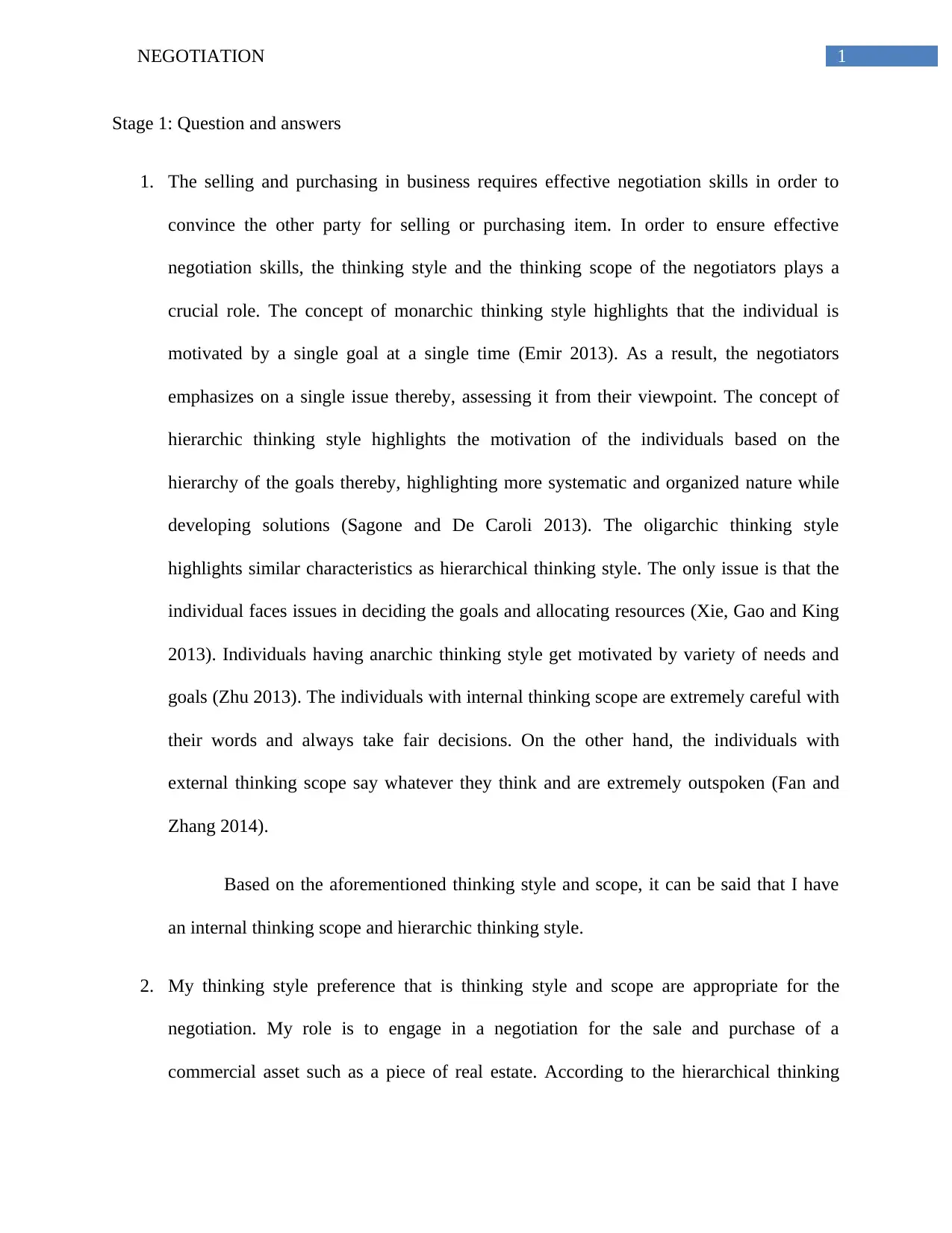
1NEGOTIATION
Stage 1: Question and answers
1. The selling and purchasing in business requires effective negotiation skills in order to
convince the other party for selling or purchasing item. In order to ensure effective
negotiation skills, the thinking style and the thinking scope of the negotiators plays a
crucial role. The concept of monarchic thinking style highlights that the individual is
motivated by a single goal at a single time (Emir 2013). As a result, the negotiators
emphasizes on a single issue thereby, assessing it from their viewpoint. The concept of
hierarchic thinking style highlights the motivation of the individuals based on the
hierarchy of the goals thereby, highlighting more systematic and organized nature while
developing solutions (Sagone and De Caroli 2013). The oligarchic thinking style
highlights similar characteristics as hierarchical thinking style. The only issue is that the
individual faces issues in deciding the goals and allocating resources (Xie, Gao and King
2013). Individuals having anarchic thinking style get motivated by variety of needs and
goals (Zhu 2013). The individuals with internal thinking scope are extremely careful with
their words and always take fair decisions. On the other hand, the individuals with
external thinking scope say whatever they think and are extremely outspoken (Fan and
Zhang 2014).
Based on the aforementioned thinking style and scope, it can be said that I have
an internal thinking scope and hierarchic thinking style.
2. My thinking style preference that is thinking style and scope are appropriate for the
negotiation. My role is to engage in a negotiation for the sale and purchase of a
commercial asset such as a piece of real estate. According to the hierarchical thinking
Stage 1: Question and answers
1. The selling and purchasing in business requires effective negotiation skills in order to
convince the other party for selling or purchasing item. In order to ensure effective
negotiation skills, the thinking style and the thinking scope of the negotiators plays a
crucial role. The concept of monarchic thinking style highlights that the individual is
motivated by a single goal at a single time (Emir 2013). As a result, the negotiators
emphasizes on a single issue thereby, assessing it from their viewpoint. The concept of
hierarchic thinking style highlights the motivation of the individuals based on the
hierarchy of the goals thereby, highlighting more systematic and organized nature while
developing solutions (Sagone and De Caroli 2013). The oligarchic thinking style
highlights similar characteristics as hierarchical thinking style. The only issue is that the
individual faces issues in deciding the goals and allocating resources (Xie, Gao and King
2013). Individuals having anarchic thinking style get motivated by variety of needs and
goals (Zhu 2013). The individuals with internal thinking scope are extremely careful with
their words and always take fair decisions. On the other hand, the individuals with
external thinking scope say whatever they think and are extremely outspoken (Fan and
Zhang 2014).
Based on the aforementioned thinking style and scope, it can be said that I have
an internal thinking scope and hierarchic thinking style.
2. My thinking style preference that is thinking style and scope are appropriate for the
negotiation. My role is to engage in a negotiation for the sale and purchase of a
commercial asset such as a piece of real estate. According to the hierarchical thinking
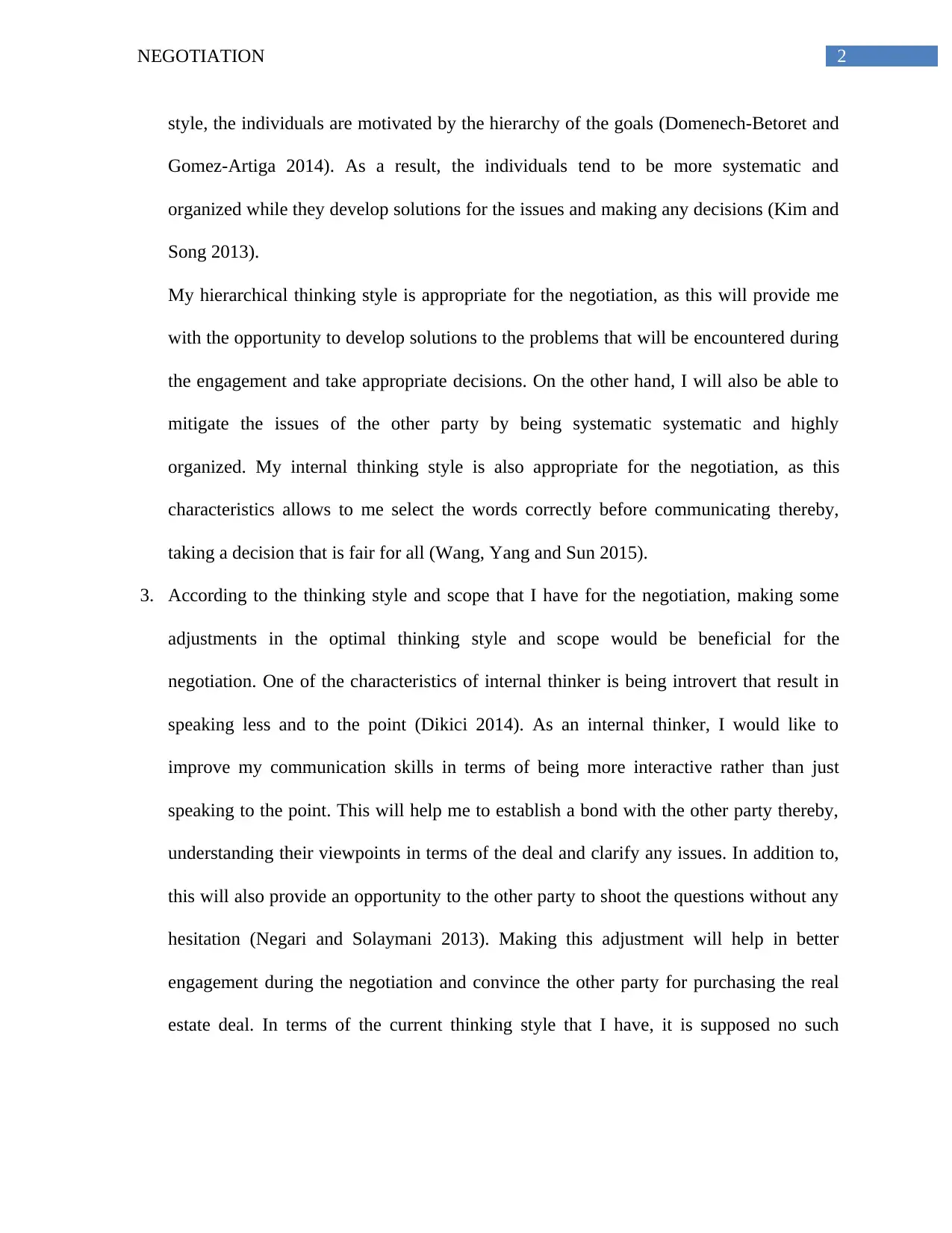
2NEGOTIATION
style, the individuals are motivated by the hierarchy of the goals (Domenech-Betoret and
Gomez-Artiga 2014). As a result, the individuals tend to be more systematic and
organized while they develop solutions for the issues and making any decisions (Kim and
Song 2013).
My hierarchical thinking style is appropriate for the negotiation, as this will provide me
with the opportunity to develop solutions to the problems that will be encountered during
the engagement and take appropriate decisions. On the other hand, I will also be able to
mitigate the issues of the other party by being systematic systematic and highly
organized. My internal thinking style is also appropriate for the negotiation, as this
characteristics allows to me select the words correctly before communicating thereby,
taking a decision that is fair for all (Wang, Yang and Sun 2015).
3. According to the thinking style and scope that I have for the negotiation, making some
adjustments in the optimal thinking style and scope would be beneficial for the
negotiation. One of the characteristics of internal thinker is being introvert that result in
speaking less and to the point (Dikici 2014). As an internal thinker, I would like to
improve my communication skills in terms of being more interactive rather than just
speaking to the point. This will help me to establish a bond with the other party thereby,
understanding their viewpoints in terms of the deal and clarify any issues. In addition to,
this will also provide an opportunity to the other party to shoot the questions without any
hesitation (Negari and Solaymani 2013). Making this adjustment will help in better
engagement during the negotiation and convince the other party for purchasing the real
estate deal. In terms of the current thinking style that I have, it is supposed no such
style, the individuals are motivated by the hierarchy of the goals (Domenech-Betoret and
Gomez-Artiga 2014). As a result, the individuals tend to be more systematic and
organized while they develop solutions for the issues and making any decisions (Kim and
Song 2013).
My hierarchical thinking style is appropriate for the negotiation, as this will provide me
with the opportunity to develop solutions to the problems that will be encountered during
the engagement and take appropriate decisions. On the other hand, I will also be able to
mitigate the issues of the other party by being systematic systematic and highly
organized. My internal thinking style is also appropriate for the negotiation, as this
characteristics allows to me select the words correctly before communicating thereby,
taking a decision that is fair for all (Wang, Yang and Sun 2015).
3. According to the thinking style and scope that I have for the negotiation, making some
adjustments in the optimal thinking style and scope would be beneficial for the
negotiation. One of the characteristics of internal thinker is being introvert that result in
speaking less and to the point (Dikici 2014). As an internal thinker, I would like to
improve my communication skills in terms of being more interactive rather than just
speaking to the point. This will help me to establish a bond with the other party thereby,
understanding their viewpoints in terms of the deal and clarify any issues. In addition to,
this will also provide an opportunity to the other party to shoot the questions without any
hesitation (Negari and Solaymani 2013). Making this adjustment will help in better
engagement during the negotiation and convince the other party for purchasing the real
estate deal. In terms of the current thinking style that I have, it is supposed no such
⊘ This is a preview!⊘
Do you want full access?
Subscribe today to unlock all pages.

Trusted by 1+ million students worldwide
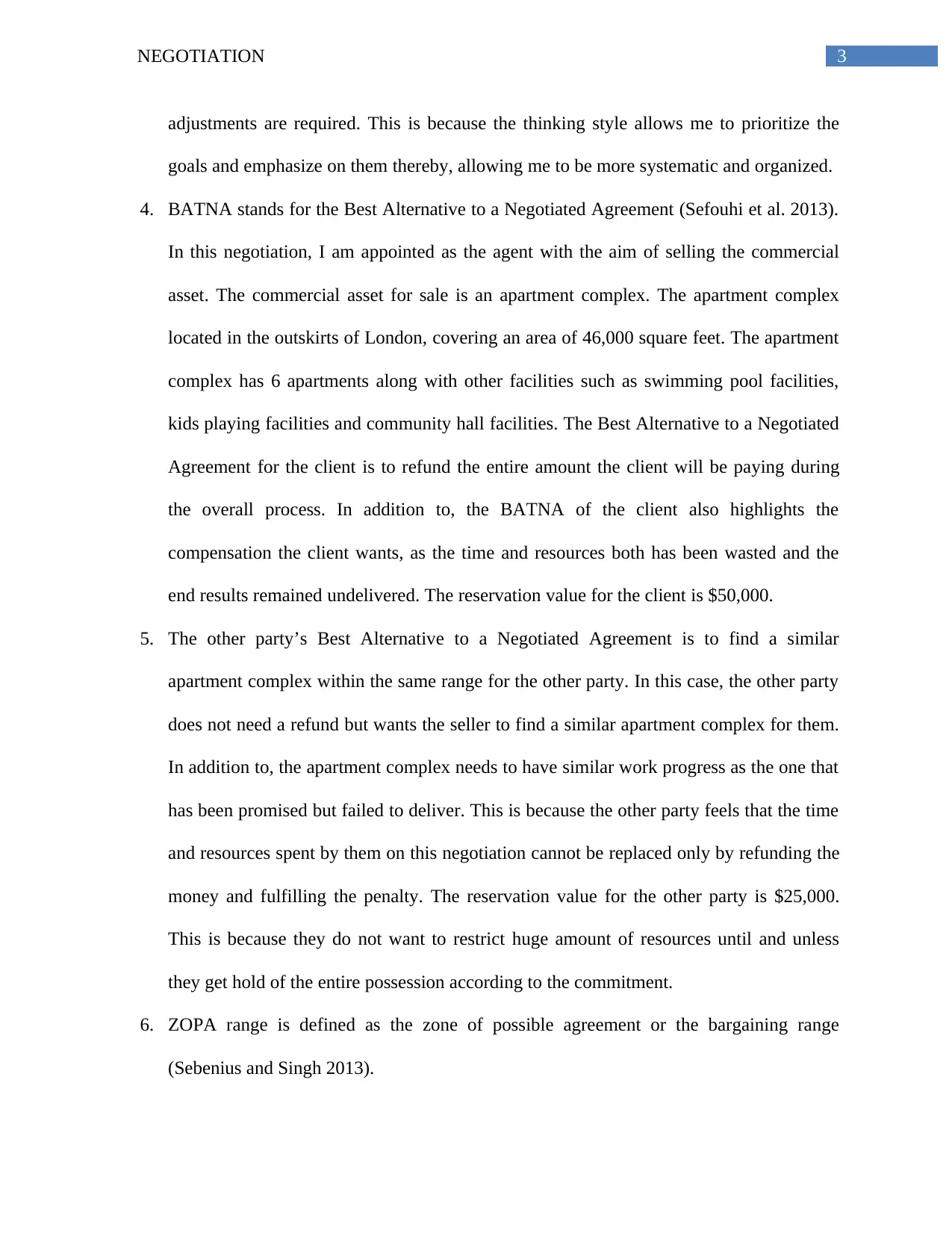
3NEGOTIATION
adjustments are required. This is because the thinking style allows me to prioritize the
goals and emphasize on them thereby, allowing me to be more systematic and organized.
4. BATNA stands for the Best Alternative to a Negotiated Agreement (Sefouhi et al. 2013).
In this negotiation, I am appointed as the agent with the aim of selling the commercial
asset. The commercial asset for sale is an apartment complex. The apartment complex
located in the outskirts of London, covering an area of 46,000 square feet. The apartment
complex has 6 apartments along with other facilities such as swimming pool facilities,
kids playing facilities and community hall facilities. The Best Alternative to a Negotiated
Agreement for the client is to refund the entire amount the client will be paying during
the overall process. In addition to, the BATNA of the client also highlights the
compensation the client wants, as the time and resources both has been wasted and the
end results remained undelivered. The reservation value for the client is $50,000.
5. The other party’s Best Alternative to a Negotiated Agreement is to find a similar
apartment complex within the same range for the other party. In this case, the other party
does not need a refund but wants the seller to find a similar apartment complex for them.
In addition to, the apartment complex needs to have similar work progress as the one that
has been promised but failed to deliver. This is because the other party feels that the time
and resources spent by them on this negotiation cannot be replaced only by refunding the
money and fulfilling the penalty. The reservation value for the other party is $25,000.
This is because they do not want to restrict huge amount of resources until and unless
they get hold of the entire possession according to the commitment.
6. ZOPA range is defined as the zone of possible agreement or the bargaining range
(Sebenius and Singh 2013).
adjustments are required. This is because the thinking style allows me to prioritize the
goals and emphasize on them thereby, allowing me to be more systematic and organized.
4. BATNA stands for the Best Alternative to a Negotiated Agreement (Sefouhi et al. 2013).
In this negotiation, I am appointed as the agent with the aim of selling the commercial
asset. The commercial asset for sale is an apartment complex. The apartment complex
located in the outskirts of London, covering an area of 46,000 square feet. The apartment
complex has 6 apartments along with other facilities such as swimming pool facilities,
kids playing facilities and community hall facilities. The Best Alternative to a Negotiated
Agreement for the client is to refund the entire amount the client will be paying during
the overall process. In addition to, the BATNA of the client also highlights the
compensation the client wants, as the time and resources both has been wasted and the
end results remained undelivered. The reservation value for the client is $50,000.
5. The other party’s Best Alternative to a Negotiated Agreement is to find a similar
apartment complex within the same range for the other party. In this case, the other party
does not need a refund but wants the seller to find a similar apartment complex for them.
In addition to, the apartment complex needs to have similar work progress as the one that
has been promised but failed to deliver. This is because the other party feels that the time
and resources spent by them on this negotiation cannot be replaced only by refunding the
money and fulfilling the penalty. The reservation value for the other party is $25,000.
This is because they do not want to restrict huge amount of resources until and unless
they get hold of the entire possession according to the commitment.
6. ZOPA range is defined as the zone of possible agreement or the bargaining range
(Sebenius and Singh 2013).
Paraphrase This Document
Need a fresh take? Get an instant paraphrase of this document with our AI Paraphraser
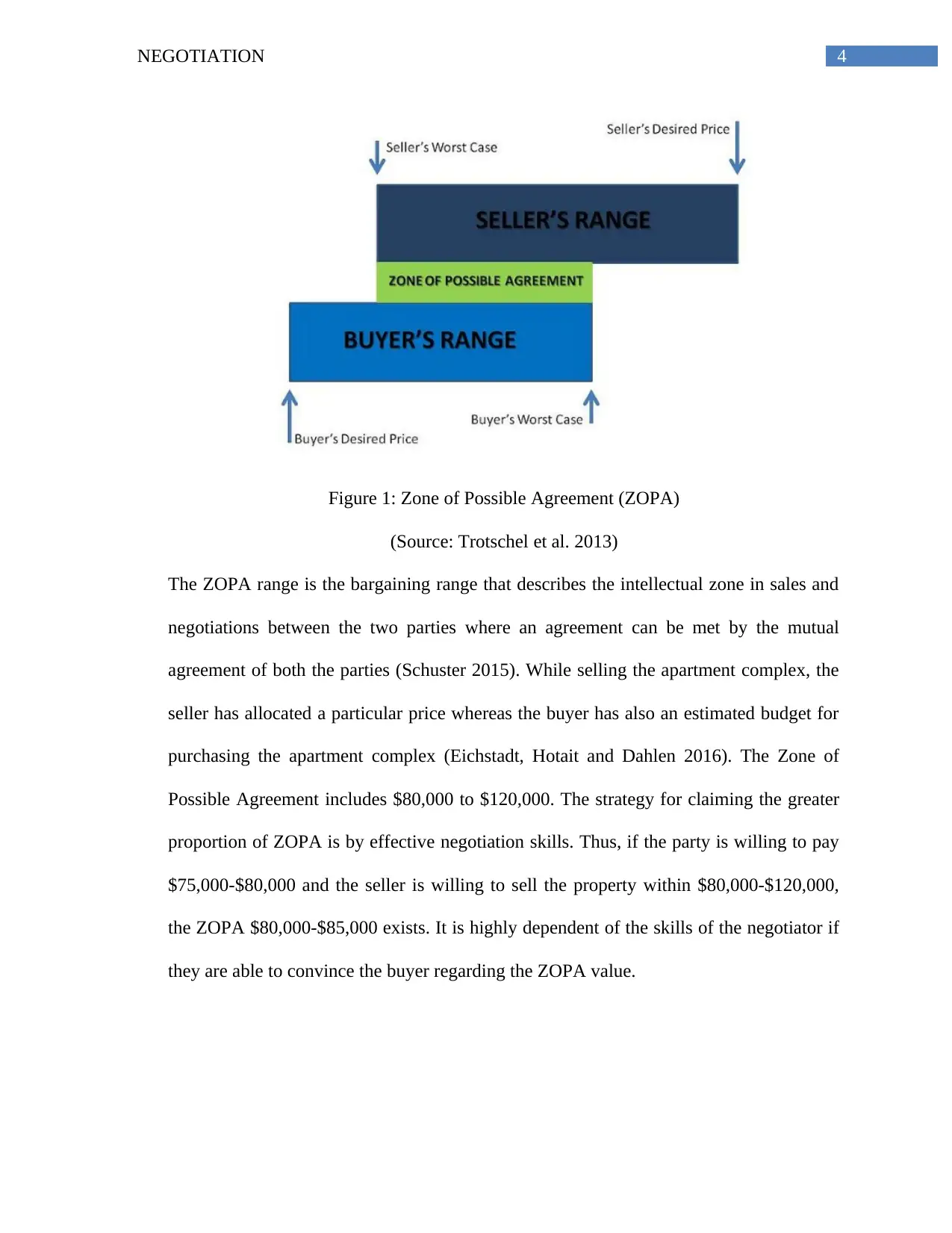
4NEGOTIATION
Figure 1: Zone of Possible Agreement (ZOPA)
(Source: Trotschel et al. 2013)
The ZOPA range is the bargaining range that describes the intellectual zone in sales and
negotiations between the two parties where an agreement can be met by the mutual
agreement of both the parties (Schuster 2015). While selling the apartment complex, the
seller has allocated a particular price whereas the buyer has also an estimated budget for
purchasing the apartment complex (Eichstadt, Hotait and Dahlen 2016). The Zone of
Possible Agreement includes $80,000 to $120,000. The strategy for claiming the greater
proportion of ZOPA is by effective negotiation skills. Thus, if the party is willing to pay
$75,000-$80,000 and the seller is willing to sell the property within $80,000-$120,000,
the ZOPA $80,000-$85,000 exists. It is highly dependent of the skills of the negotiator if
they are able to convince the buyer regarding the ZOPA value.
Figure 1: Zone of Possible Agreement (ZOPA)
(Source: Trotschel et al. 2013)
The ZOPA range is the bargaining range that describes the intellectual zone in sales and
negotiations between the two parties where an agreement can be met by the mutual
agreement of both the parties (Schuster 2015). While selling the apartment complex, the
seller has allocated a particular price whereas the buyer has also an estimated budget for
purchasing the apartment complex (Eichstadt, Hotait and Dahlen 2016). The Zone of
Possible Agreement includes $80,000 to $120,000. The strategy for claiming the greater
proportion of ZOPA is by effective negotiation skills. Thus, if the party is willing to pay
$75,000-$80,000 and the seller is willing to sell the property within $80,000-$120,000,
the ZOPA $80,000-$85,000 exists. It is highly dependent of the skills of the negotiator if
they are able to convince the buyer regarding the ZOPA value.
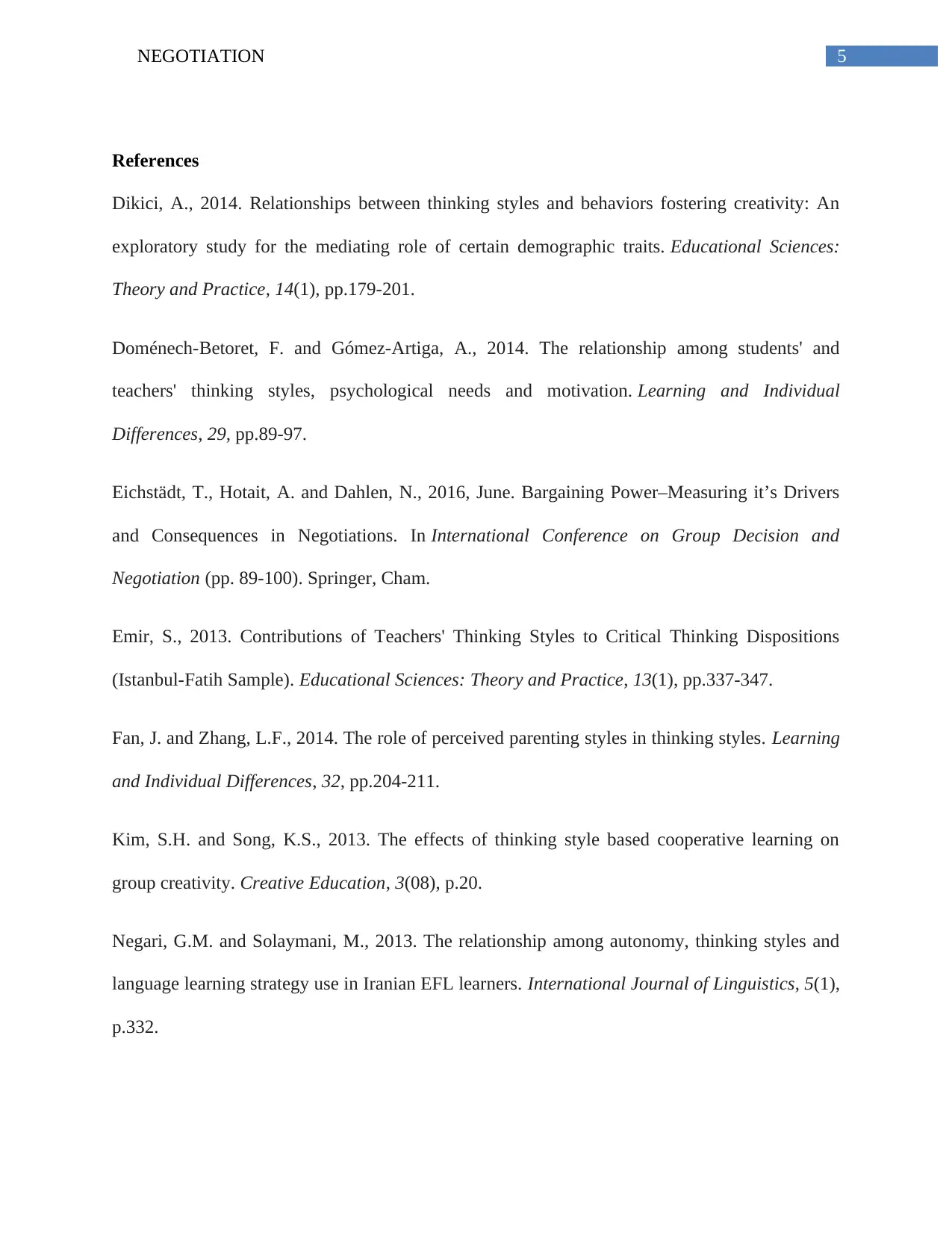
5NEGOTIATION
References
Dikici, A., 2014. Relationships between thinking styles and behaviors fostering creativity: An
exploratory study for the mediating role of certain demographic traits. Educational Sciences:
Theory and Practice, 14(1), pp.179-201.
Doménech-Betoret, F. and Gómez-Artiga, A., 2014. The relationship among students' and
teachers' thinking styles, psychological needs and motivation. Learning and Individual
Differences, 29, pp.89-97.
Eichstädt, T., Hotait, A. and Dahlen, N., 2016, June. Bargaining Power–Measuring it’s Drivers
and Consequences in Negotiations. In International Conference on Group Decision and
Negotiation (pp. 89-100). Springer, Cham.
Emir, S., 2013. Contributions of Teachers' Thinking Styles to Critical Thinking Dispositions
(Istanbul-Fatih Sample). Educational Sciences: Theory and Practice, 13(1), pp.337-347.
Fan, J. and Zhang, L.F., 2014. The role of perceived parenting styles in thinking styles. Learning
and Individual Differences, 32, pp.204-211.
Kim, S.H. and Song, K.S., 2013. The effects of thinking style based cooperative learning on
group creativity. Creative Education, 3(08), p.20.
Negari, G.M. and Solaymani, M., 2013. The relationship among autonomy, thinking styles and
language learning strategy use in Iranian EFL learners. International Journal of Linguistics, 5(1),
p.332.
References
Dikici, A., 2014. Relationships between thinking styles and behaviors fostering creativity: An
exploratory study for the mediating role of certain demographic traits. Educational Sciences:
Theory and Practice, 14(1), pp.179-201.
Doménech-Betoret, F. and Gómez-Artiga, A., 2014. The relationship among students' and
teachers' thinking styles, psychological needs and motivation. Learning and Individual
Differences, 29, pp.89-97.
Eichstädt, T., Hotait, A. and Dahlen, N., 2016, June. Bargaining Power–Measuring it’s Drivers
and Consequences in Negotiations. In International Conference on Group Decision and
Negotiation (pp. 89-100). Springer, Cham.
Emir, S., 2013. Contributions of Teachers' Thinking Styles to Critical Thinking Dispositions
(Istanbul-Fatih Sample). Educational Sciences: Theory and Practice, 13(1), pp.337-347.
Fan, J. and Zhang, L.F., 2014. The role of perceived parenting styles in thinking styles. Learning
and Individual Differences, 32, pp.204-211.
Kim, S.H. and Song, K.S., 2013. The effects of thinking style based cooperative learning on
group creativity. Creative Education, 3(08), p.20.
Negari, G.M. and Solaymani, M., 2013. The relationship among autonomy, thinking styles and
language learning strategy use in Iranian EFL learners. International Journal of Linguistics, 5(1),
p.332.
⊘ This is a preview!⊘
Do you want full access?
Subscribe today to unlock all pages.

Trusted by 1+ million students worldwide
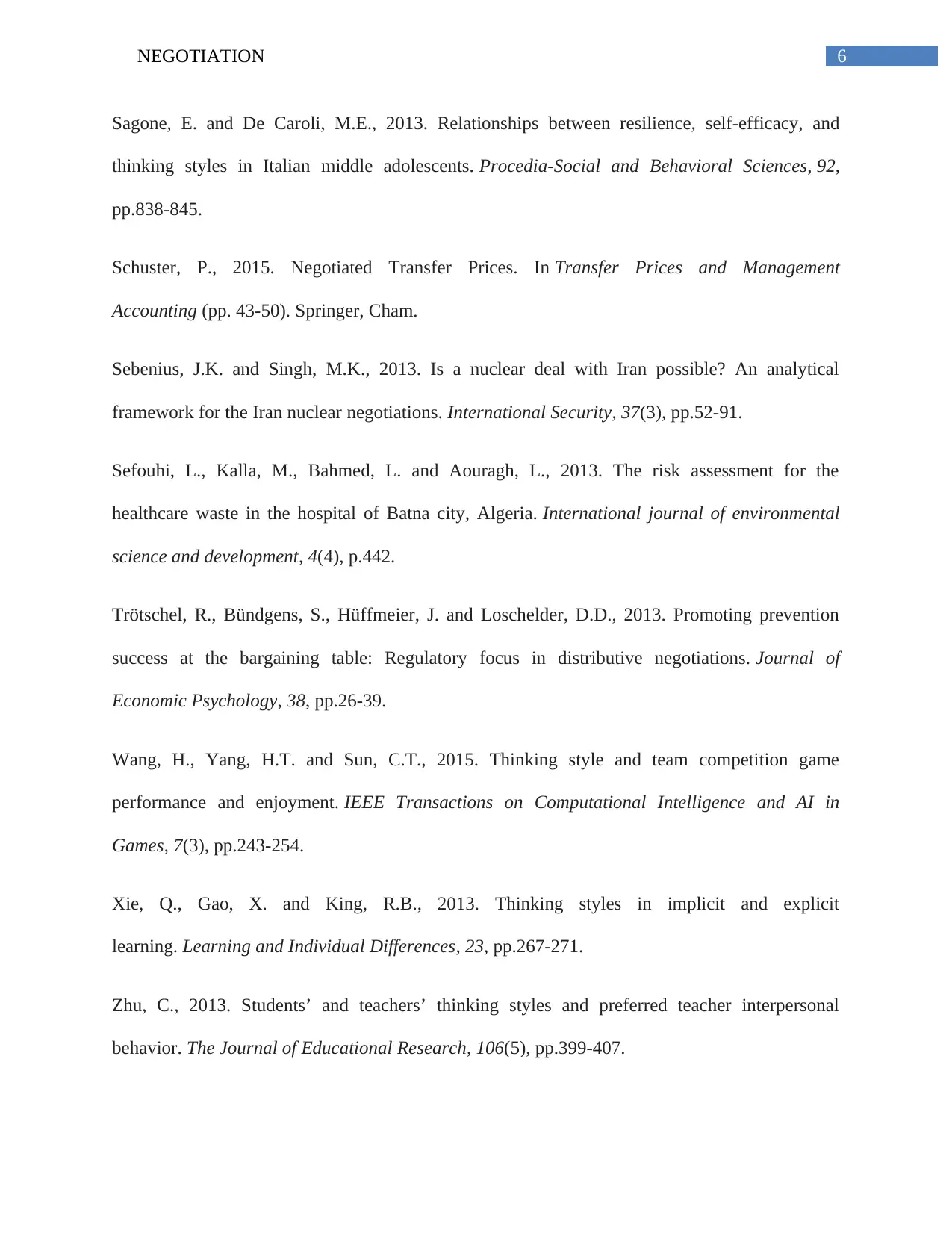
6NEGOTIATION
Sagone, E. and De Caroli, M.E., 2013. Relationships between resilience, self-efficacy, and
thinking styles in Italian middle adolescents. Procedia-Social and Behavioral Sciences, 92,
pp.838-845.
Schuster, P., 2015. Negotiated Transfer Prices. In Transfer Prices and Management
Accounting (pp. 43-50). Springer, Cham.
Sebenius, J.K. and Singh, M.K., 2013. Is a nuclear deal with Iran possible? An analytical
framework for the Iran nuclear negotiations. International Security, 37(3), pp.52-91.
Sefouhi, L., Kalla, M., Bahmed, L. and Aouragh, L., 2013. The risk assessment for the
healthcare waste in the hospital of Batna city, Algeria. International journal of environmental
science and development, 4(4), p.442.
Trötschel, R., Bündgens, S., Hüffmeier, J. and Loschelder, D.D., 2013. Promoting prevention
success at the bargaining table: Regulatory focus in distributive negotiations. Journal of
Economic Psychology, 38, pp.26-39.
Wang, H., Yang, H.T. and Sun, C.T., 2015. Thinking style and team competition game
performance and enjoyment. IEEE Transactions on Computational Intelligence and AI in
Games, 7(3), pp.243-254.
Xie, Q., Gao, X. and King, R.B., 2013. Thinking styles in implicit and explicit
learning. Learning and Individual Differences, 23, pp.267-271.
Zhu, C., 2013. Students’ and teachers’ thinking styles and preferred teacher interpersonal
behavior. The Journal of Educational Research, 106(5), pp.399-407.
Sagone, E. and De Caroli, M.E., 2013. Relationships between resilience, self-efficacy, and
thinking styles in Italian middle adolescents. Procedia-Social and Behavioral Sciences, 92,
pp.838-845.
Schuster, P., 2015. Negotiated Transfer Prices. In Transfer Prices and Management
Accounting (pp. 43-50). Springer, Cham.
Sebenius, J.K. and Singh, M.K., 2013. Is a nuclear deal with Iran possible? An analytical
framework for the Iran nuclear negotiations. International Security, 37(3), pp.52-91.
Sefouhi, L., Kalla, M., Bahmed, L. and Aouragh, L., 2013. The risk assessment for the
healthcare waste in the hospital of Batna city, Algeria. International journal of environmental
science and development, 4(4), p.442.
Trötschel, R., Bündgens, S., Hüffmeier, J. and Loschelder, D.D., 2013. Promoting prevention
success at the bargaining table: Regulatory focus in distributive negotiations. Journal of
Economic Psychology, 38, pp.26-39.
Wang, H., Yang, H.T. and Sun, C.T., 2015. Thinking style and team competition game
performance and enjoyment. IEEE Transactions on Computational Intelligence and AI in
Games, 7(3), pp.243-254.
Xie, Q., Gao, X. and King, R.B., 2013. Thinking styles in implicit and explicit
learning. Learning and Individual Differences, 23, pp.267-271.
Zhu, C., 2013. Students’ and teachers’ thinking styles and preferred teacher interpersonal
behavior. The Journal of Educational Research, 106(5), pp.399-407.
Paraphrase This Document
Need a fresh take? Get an instant paraphrase of this document with our AI Paraphraser

7NEGOTIATION
1 out of 8
Related Documents
Your All-in-One AI-Powered Toolkit for Academic Success.
+13062052269
info@desklib.com
Available 24*7 on WhatsApp / Email
![[object Object]](/_next/static/media/star-bottom.7253800d.svg)
Unlock your academic potential
Copyright © 2020–2025 A2Z Services. All Rights Reserved. Developed and managed by ZUCOL.





